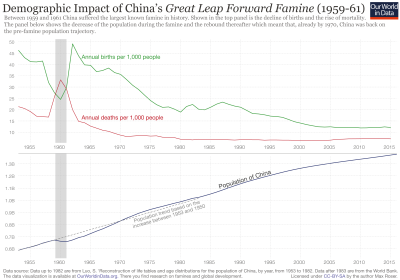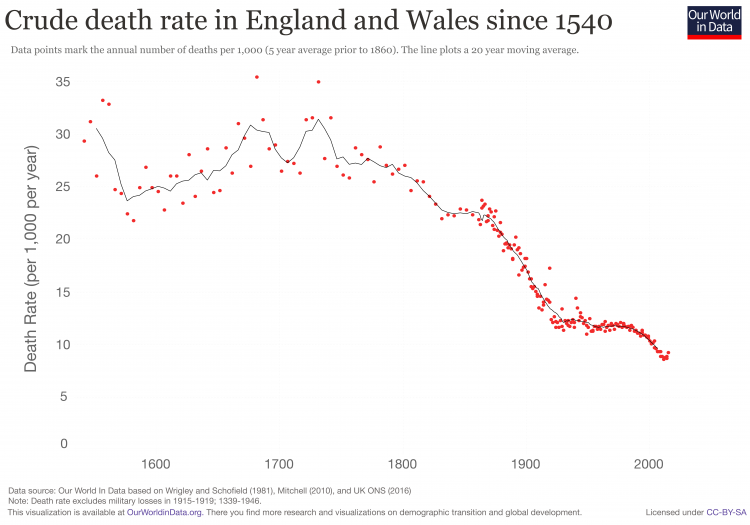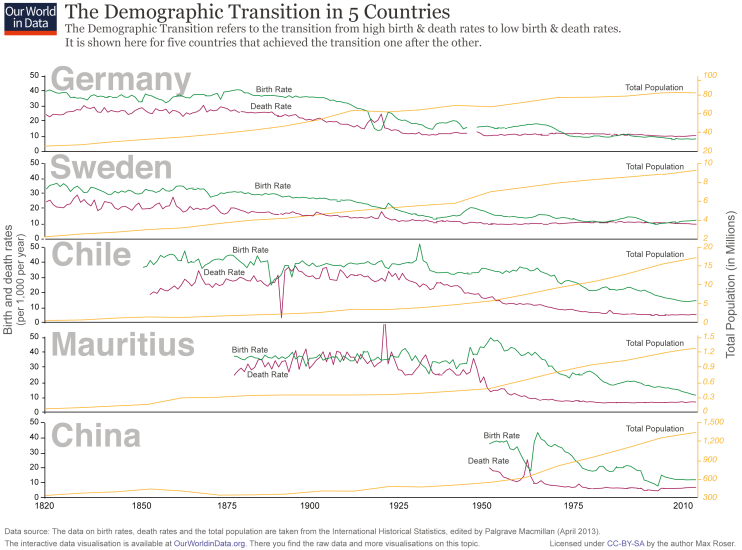This article is the second of a pair of blogs which consider the relationship between famines and population growth. In the first we look at whether population growth is the dominant driver of famine and hunger. Here we consider the demographic impacts of famines, and in particular the extent to which famines may curb population growth.
Is famine the ultimate ‘check’?
English political economist, Thomas Robert Malthus, writing at the turn of the 19th century, is famous for describing famine as “the last, the most dreadful resource of nature” which acts to “level the population with the food of the world” should other forces fail to lower birth rates or increase death rates.1
We can think of this ‘Malthusian’ proposition as containing two separate hypotheses: firstly, that unabated population growth ultimately leads to famine; secondly, that famine acts as a ‘check’ to population in this eventuality.
As we discuss here, recent trends in famine mortality, and hunger more generally, largely contradict the first hypothesis. Here we investigate the second, by considering the contribution of famines to long-run population trends. What role has famine played in shaping birth and mortality rates throughout history?
We begin by considering two examples of famines which, from a demographic point of view, differ enormously: the Chinese famine of 1959-61 and that in Ireland in the late 1840s.
China’s ‘Great Leap Forward’ famine
The ‘Great Leap Forward’-famine in China from 1959-61 was the single largest famine in history in terms of absolute numbers of deaths. Excess mortality estimates vary hugely, but based on our midpoint estimates, it cost more than double the number of lives than any other famine. Our table of famine mortality estimates is available here. This chart shows the estimated changes to birth and death rates during and after this famine period, in addition to the effect of these changes on overall population size. Alongside a significant jump in death rates, there was also a large fall in births — a trend very typical of famines.2
However, this was immediately followed by a spike in birth rates in the years immediately following the famine, offsetting to a large degree its demographic effect. This was followed by a steady decline in birth rates throughout the 1960s and 70s, concurrent with domestic birth control policies, but also in line with many other rapidly developing countries.
The trend in mortality rates is similar: the peak generated by the crisis was followed by a continued decline that forms part of the common experience of countries as they develop. The key thing to note is that these secular shifts in births and deaths far outweigh the short-lived impact of the famine in determining the long-run trajectory of population growth in China. Despite causing an excess mortality of 2-5% of the total population, and a similar number of ‘lost births’, we can see from the lower panel in the chart below the famine had next to no discernible impact on population in the long run.
Long-term demographic impact of China’s Great Leap Forward Famine3

The Great Irish Famine
This picture contrasts somewhat with the developments following the Great Irish Famine of the late 1840s, as shown in the chart below. After a period of rapid growth that brought the population to over 8 million, a famine struck that was, in relation to the country’s population, far more severe than the ‘Great Leap Forward’-famine. It is thought to have reduced the population by about one quarter in its immediate effects: one million perishing and a further million emigrating. But one striking feature of Irish demographics is how the population then continued to shrink following the famine. By 1911 there were in Ireland about half as many people as in 1841. The population only began to grow again in the late 20th century. Is this then an example of a country that learnt from its ‘Malthusian lesson’?
This continued depopulation was partly due to low birth rates (which were considerably lower than in England and Scotland in the second half of the 19th century) and partly due to very high levels of outward migration, particularly to the US and Great Britain. Between 1851 and 1900, there were almost as many outward migrants as there were deaths in Ireland (4.18 million and 4.56 million, respectively).5 According to Cormac Ó Gráda, “during the decades between the Great Famine and World War One the probability of a young Irishman or Irishwoman not emigrating was less than one in two.“
As Ó Gráda argues, the only way a famine can have any real lasting demographic impact is if it “teaches” the population to alter marriage and family planning practices to reduce fertility rates.6
There is some evidence of changing behaviour in Ireland following the famine, including more people choosing to marry later or not all. However it is difficult to know if this is directly attributable to the famine, or if it instead reflects people’s responses to other changes taking place at the time, such as increasing life expectancy or increasing incomes. Furthermore, whilst total birth rates were low in the post-famine period, the number of children being born to married couples remained high, and the rate of natural increase was highest in those parts of the country worst hit by the famine, complicating any simple explanation along these lines. Similarly, whilst the famine itself clearly provided the impetus for mass emigration, high levels of outward migration began some decades before the famine and continued long afterwards in the context of a much-ameliorated standard of living. Thus, it seems likely that it was the promise of improved economic opportunities, rather than fear of famine which drove emigration between 1851 and 1900.7
Overall then, even in this seemingly paradigmatic ‘Malthusian’ example, whilst Ireland undoubtedly did suffer some lasting demographic impacts from the famine, subsequent economic and social developments unrelated to the famine explain the majority of the depopulation the country experienced in the decades following it.
Population of the Island of Ireland, 1500-20004
The role of ‘crises’ in long-run population trends
But what can we say about the impact of famines on long-term population trends more generally? To help answer this question, we look instead at the role of ‘population crises’ of all kinds – that is to say severe spikes in mortality in general, not just those due to famine. What impact have such crises played in shaping population trends, relative to other global developments?
Here are two charts showing the historic evolution of death rates in England and Wales, and in Norway. Data points mark the annual ‘Crude Death Rate’ (total deaths per 1,000 people) in each country, and a line plotting the 20-year moving average is shown in each case. You can see that the decline in average mortality rates in both countries was preceded by a reduction in the spread around the average i.e., the number and extent of ‘crises’ of high mortality.8
However, when such spikes were common, they in fact played a relatively small part in keeping average mortality rates as high as they were. Economic Historian, Robert Fogel, in considering the data for England concludes that “crisis mortality9 [including famine] accounted for less than 5 percent of total mortality in England prior to 1800 and the elimination of crisis mortality accounted for just 15 percent of the decline in total mortality between the eighteenth and nineteenth centuries.”10
You can picture this by imagining what would happen if you took the highest points in the charts above – representing the crises in mortality – and moved them downwards towards the average for that time. The line showing the 20-year moving average would indeed fall, but only by a small amount compared to the overall decline.
Historic crude death rates in England and Wales

Historic crude death rates in Norway

Falling death rates, and increasing life expectancy, are trends that took place first in early industrialising countries, but have been a common experience in all parts of the world as poverty has declined, and healthcare and nutrition has improved. But since the 1960s this has been outpaced by a fall in birth rates, such that overall the global population growth rate has been steadily falling, and is likely to approach zero towards the end of this century. The rapid growth in population witnessed since the early 20th century was due to the fall in death rates happening ahead of the fall in birth rates, generating a period of natural increase in between.
This is known as the ‘demographic transition‘: a shift from stable populations with high birth and death rates to stable populations with low birth and death rates, with a period of rapid increase in between due to the fall in mortality preceding the fall in fertility. This chart shows this transition as it occurred in five very different countries. Here also we can see that the secular decline in death rates follow a reduction in its volatility. But again, the height of the peaks in earlier decades are generally small relative to the overall decline. Even larger crises, such as the “Great Leap Forward”, or the spike in mortality in Mauritius in the late 1920s,11 translate into very small changes in overall population trends, if at all. It is the persistent long-term decline in ‘normal’ birth and death rates that represent the more significant development for population trends, not the absence of temporary mortality spikes.
Demographic transition in 5 countries, 1820-201012

Famines are no ‘solution’ to population growth
As with any living organism, humans cannot sustain a given population without sufficient energy resources. Given this, at first glance, it does seem intuitive to assume population growth and famines to be closely linked via food availability. The evidence discussed here (and also here) contradicts any simplified view of this relationship that fails to acknowledge the diverse causes of famines and population dynamics.
The analogy to other living organisms can obscure what is different about the human species. We organize ourselves into complex social and political structures capable of incredible joint accomplishments – such as the eradication of diseases. But we are also capable of inflicting, or consciously allowing, unimaginable suffering – including the majority of famine deaths to date. The capacity of the planet to feed us is not a fixed constant, imposed by nature, but rather it depends also on us: on our agricultural practices, the development and transmission of knowledge and technology, and also crucially upon our choice of diet – an inherently cultural act.
The population growth rate is now declining, not, thankfully, due to more frequent crises of mortality but because people, through their own volition, are choosing to have fewer children. This change is very much associated to rising incomes and other social developments in health and education, and has tended to happen more quickly in countries that have developed more recently. If we need any generalization here, it is plenty – in terms of improved access to adequate food, clean water, sanitation, healthcare, education and so on – rather than scarcity, that is slowing down our species’ multiplication.
This isn’t to say that increased populations and affluence haven’t brought about environmental damage, nor that environmental degradation poses no risks to our future well-being. But the idea we are helpless to stop famines in the face of high population growth in some parts of the world, or that famines represents any kind of ‘solution’ to the environmental problems humans are causing, are two hypotheses that do little to help either humanity or the planet.